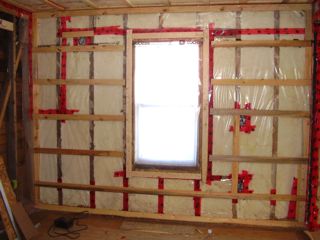Vapor Barriers
 Uses and Characteristics
Uses and Characteristics Vapor barriers are an important part of moisture control for interiors. A vapor barrier is a material, typically a plastic or foil sheet, which resists the diffusion of moisture through ceiling, wall and floor assemblies of a building. Vapor-diffusion retarders are also effective for controlling moisture in basements, crawlspaces, and slab-on-grade foundations.
The capability of a given material to resist the diffusion of water vapor is measured by units called "perms," which quantify its permeability. A perm at 73.4° F (23° C) is a measure of the number of grains of water vapor passing through a square foot of material per hour at a differential vapor pressure equal to 1 inch of mercury (1-inch water column or WC). Any material with a perm rating of less than 1 is considered a vapor retarder.
Regional Applications

Pros and Cons of Different Materials
Vapor-retardant paint is a latex primer available for interior applications. It behaves and is applied the same way as standard latex primer, and has a perm rating of about 0.7. Vapor-retardant paint can be tinted, and it can be applied on new gypsum board and over painted surfaces. The cost per gallon is comparable to standard paint.
- Pros: The vapor-retardant function comes at virtually no additional cost in situations where interior primers alone can be used. Vapor-retardant paint is the simplest application in an instance where it is not desirable to significantly alter the existing wallboard or plaster surface.
- Cons: The paint is only appropriate for interior wall surface applications. Damage to paint can compromise its retarding ability, as can inadequate prep work before application. If all penetrations and material intersections on the interior wall surface are not fully caulked or otherwise sealed, the paint will not be completely effective.
Treated paper or foil used as a vapor retarder typically comes in the form of kraft or foil-faced batt insulation. It is useful in situations where the wall finish has been removed and new exterior wall insulation is being installed, as well as in new builds. This type is most effective in mixed climates with low humidity, since the amount of unsealed edge will allow a path for moisture-vapor migration.
- Pros: This is a very cost-effective option, since batt insulation and a vapor retarder can be installed in one step.
- Cons: It can be installed only during a new build or in a situation where the walls have been stripped to the rough framing. The number of joints and edges inherent in this installation don’t allow for an extremely efficient vapor retarder, though it is sufficient for mixed climates or heating climates where humidity is controlled.
Clear polyethylene is the most basic, plastic barrier film available, as well as the most economical, and is best suited to interior wall applications over framing and insulation. It is also an environmentally friendly choice since it is comprised of up to 80% re-processed material, but this comes at a cost, as the quality can be uneven, making it prone to tearing and puncturing. This type of vapor-retardant material is not recommended for applications where it will be subjected to more than a limited amount of direct sunlight, as it will degrade over time. 
- Pros: It is inexpensive and fairly easy to install. Because the material is translucent, it is easy to attach to framing members, and installing wallboard over the plastic is simple, as well. Clear polyethylene is most effective in severe heating climates.
- Cons: This material is fairly flimsy and can be easily damaged during installation. It incorporates limited resistance to punctures and tears. Any penetrations, such as for an electrical junction box, must be taped and sealed in order to form an effective barrier.
- Pros: It can be used for exterior wall surface applications in hot and humid cooling climates where it may be exposed to sunlight.
- Cons: It has issues similar to clear polyethylene, such as flimsiness, in addition to losing the ease of installation afforded by clear plastic that allows framing members to be viewed while attaching the material.
Cross-laminated and fiber-reinforced polyethylene are specialty products for applications where higher strength may be required. For retrofitting over rough, irregular surfaces, such as solid-board sheathing, these products are less susceptible to tears and punctures by lifted nail heads, splinters, and exposed, sharp corner edges. Either product would also be appropriate where rough handling and adverse site conditions are expected.
- Pros: These materials can withstand rougher handling than standard plastic sheets, being less susceptible to punctures and tears. The reinforced and laminated products are typically rated for limited UV exposure for exterior use. Black reinforced and laminated poly can be used as the required weather barrier under exterior siding and cladding.
- Cons: These materials are, again, similar to the other forms of plastic sheeting, with the added disadvantage of higher initial cost.

